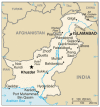Impact of community-based interventions on maternal and neonatal health indicators: Results from a community randomized trial in rural Balochistan, Pakistan
- PMID: 21054870
- PMCID: PMC2993657
- DOI: 10.1186/1742-4755-7-30
Impact of community-based interventions on maternal and neonatal health indicators: Results from a community randomized trial in rural Balochistan, Pakistan
Abstract
Background: Pakistan has high maternal mortality, particularly in the rural areas. The delay in decision making to seek medical care during obstetric emergencies remains a significant factor in maternal mortality.
Methods: We present results from an experimental study in rural Pakistan. Village clusters were randomly assigned to intervention and control arms (16 clusters each). In the intervention clusters, women were provided information on safe motherhood through pictorial booklets and audiocassettes; traditional birth attendants were trained in clean delivery and recognition of obstetric and newborn complications; and emergency transportation systems were set up. In eight of the 16 intervention clusters, husbands also received specially designed education materials on safe motherhood and family planning. Pre- and post-intervention surveys on selected maternal and neonatal health indicators were conducted in all 32 clusters. A district-wide survey was conducted two years after project completion to measure any residual impact of the interventions.
Results: Pregnant women in intervention clusters received prenatal care and prophylactic iron therapy more frequently than pregnant women in control clusters. Providing safe motherhood education to husbands resulted in further improvement of some indicators. There was a small but significant increase in percent of hospital deliveries but no impact on the use of skilled birth attendants. Perinatal mortality reduced significantly in clusters where only wives received information and education in safe motherhood. The survey to assess residual impact showed similar results.
Conclusions: We conclude that providing safe motherhood education increased the probability of pregnant women having prenatal care and utilization of health services for obstetric complications.
Figures
References
-
- National Institute of Population Studies, Pakistan & Macro International, USA. Pakistan Demographic and Health Survey 2006-07. Islamabad, Pakistan. 2007.
-
- WHO, UNICEF, UNFPA & The World Bank. Maternal mortality 1990 to 2008 Estimates developed by World Health Organization, UNICEF, United Nations Population Fund and World Bank. World Health Organization, Geneva, Switzerland; 2010.
-
- Thaddeus S, Maine D. Too far to walk: Maternal mortality in context. Social Science and Medicine. 1994;38(8):1090–1110. - PubMed
Grants and funding
LinkOut - more resources
Full Text Sources




